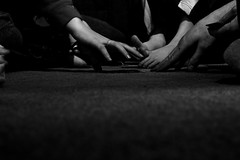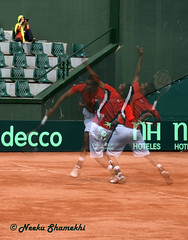Exposure – What Does It Mean?
One of the most often used words in the language of photography is “Exposure“.
Technically, exposure refers to the amount of light that reaches the imaging sensor while you’re making your photograph (or, for those of us over 20-something who remember when everything wasn’t digital, replace “imaging sensor” with “film plane”).
Most commonly, however, when we use the term “exposure” were using it to describe a certain visual aspect of a photo.
Overexposure and Underexposure
For example, you have probably seen the terms “Overexposed” and “Underexposed” used a lot when someone is describing or critiquing a photograph.
These two terms are used to describe the highlight and shadow (or bright and dark) ranges of an image.

An example of an overexposed photo with loss of detail in the bright areas of the image. (Overexposure tryout)
When someone says that a photo looks overexposed they’re noticing that the light areas of the photo are so bright that there is a loss of detail in those light areas.
You can often see this in photographs with bright light sources, like the sun or light bulbs, that are near to other objects in the frame.
If too much light was allowed to hit the camera’s sensor the light source would just appear to be white and the other light areas of the photograph will also appear overly bright.
Details like lines which you saw clearly, with your naked eye, are now less visible or completely gone (“washed out”) in the photo.
On the other end of the spectrum, an underexposed shot did not allow enough light to hit the sensor.
Underexposed photos will have dark areas where the shadows seem to run together and create larger globs of dark and black.
Even though you could clearly make out the different levels of shadow, darkness and blacks when you looked at the scene with your eyes or through your camera’s lens, it all seems to run together in an underexposed shot.
Now, if some of your photos appear to be under or overexposed, don’t worry too much about it.
See, the good thing about exposure is that it is fairly subjective.
When you visualize the photograph that you want to make, YOU are the one who knows what kind of mood you want that image to have.
So, the “proper exposure” is the one that you saw in your mind’s eye when you pressed the shutter release.
Getting that desired exposure may mean that you intentionally underexpose or intentionally overexpose your photo and there is absolutely nothing wrong with that.
Two other uses of the term exposure that you may see quite frequently are “Long Exposure” and “Multiple Exposure“.
Between the two, you’re probably more familiar with long exposure.
Long Exposure
A long exposure is, essentially, when you allow the shutter to remain open for a longer period of time in order to capture as much light as possible or as needed.
Hence, Long Exposure (makes sense, right?).

An example of a long exposure with streaking lights. (A fair ride taken with a long shutter speed.)
Long exposures are most often used for low light photography because you need to leave the shutter open in order to capture enough of the low level light to give your photo the desired appearance.
Ever see a night shot of the sky with star trails circling across the frame? How about a waterfall or stream where the water looks like a flowing sheet instead of having defined ripples? Maybe a street shot with vehicle head/taillights streaking through like laser beams?
Yep, long exposure shots.
Multiple Exposure
You may be less familiar with multiple exposure photography but it is still alive in the DSLR world even though its probably more common to use a tool like Photoshop to create the effect.
When working with film, a multiple exposure photo could be created by taking one shot and then recomposing and taking another shot without advancing the film roll.
Simply put, this captured more than one image onto a single frame so, when you developed the film, your resulting image would have two or more individually captured scenes on a single photo.
Most current DSLRs still have this feature programmed into their firmware so, even though there’s no need to advance a roll of film, you can still capture multiple exposures to a single RAW or JPEG file.
If your camera doesn’t have a multiple exposure feature you can certainly accomplish the effect post-shoot by using layers and blending modes in your favorite image editor like Adobe Photoshop or Photoshop Elements
, Adobe Photoshop Lightroom
or Gimp.
So, there you have a little bit of information about the term Exposure and how it relates to photography.
If you learned something from this article or want to pass it along to others, please “Like” and/or “Share” it through your favorite social media accounts.
Also, if you have more to add about any of the types of exposure I talked about or want to show off some of your shots as examples, I’d love to hear from you in the comments.
Just put a link to your photo or blog and everyone can check it out.
Don’t miss out on what’s coming next!
Sign up for updates so you don’t miss any of the upcoming “What Does It Mean?” articles.
When you sign up you’ll also get a FREE digital photo as a bonus gift from me so you can put my art on your walls for FREE!
‘Till next time, get out and make some exposures!
Court.
Related articles

© 2013, CEGPhoto. All rights reserved.









